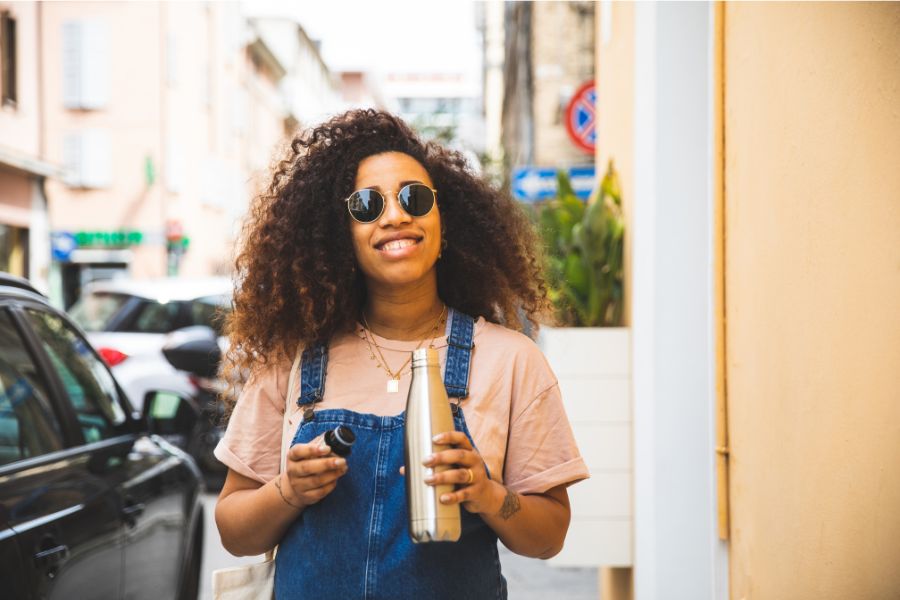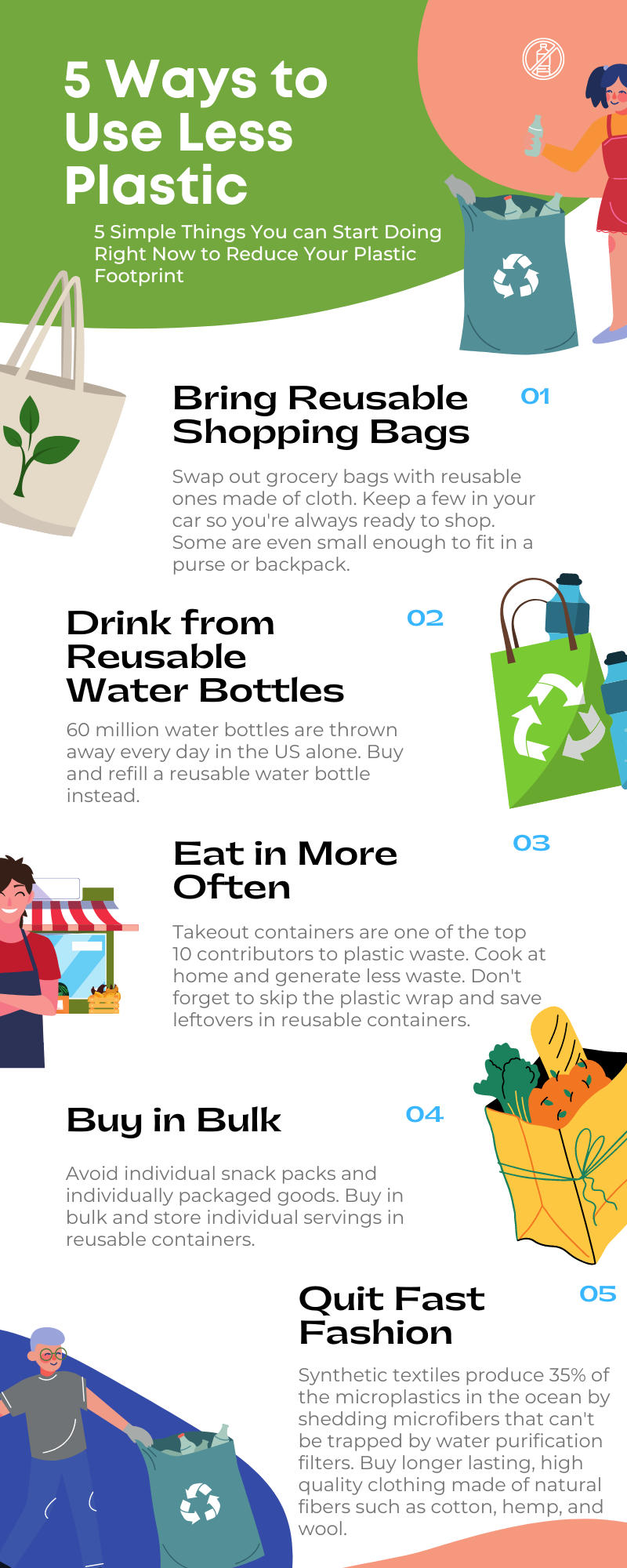There are many different ways individuals or communities can engage to reduce plastic waste. They can organize plastic pollution events, support organizations that are fighting plastic pollution, or get politically active (Cho, 2018).
Individuals can start their own cleanup of lakes, rivers, oceans, beaches, and lands (see some guidelines here: Start a Coastal Cleanup) or join existing ones. Indeed, they can adopt a beach, a lake, or any place and commit a certain amount of hours per week with the cleanups (Cho, 2018).
Everyday tips for reducing your single-use plastic consumption
- “Stop buying crap and companies will stop making crap” (Sustainable Lifestyles and Education Programme, n.d.). That is, individuals can choose/purchase sustainable products when they shop.
- Purchase reusable water bottles and spare the environment thousands of plastic bottles every year (Cho, 2018; Lindwall, 2020).
- Carry reusable shopping bags/totes with you daily (Lindwall, 2020).
- Find time to cook more often. It is not only healthier but reduces the use of plastic-heavy take-out containers (Cho, 2018; Lindwall, 2020).
- Instead of buying individual snack packs or individually packaged goods, buy in bulk, which will produce less waste (Lindwall, 2020).
- Buying online has some advantages (i.e., lower carbon footprint than shopping in a store if a person skips the “express” delivery). However, online shipments still cause plastic waste and pollution with wrappings, protection bubbles, and packaging. Thus, walking, biking, or taking public transportation to buy in-person are feasible alternatives (Lindwall, 2020).
- Avoid or reduce plastic wrap by storing leftovers in reusable containers. For instance, there are alternative containers such as beeswax wrap, bamboo, corn-starch, potato-starch, cocoa bean shells, grass paper, wood, cotton, hemp, algae, lignin or mycelium (mushroom), cloth snack pouches, silicone bags, glass storage containers, paper, and scrubber (Cho, 2018; Lindwall, 2020; Sustain my cooking habit, 2020).
- Avoid personal care products that contain microbeads (bits of plastic used as exfoliants). Congress passed the Microbead-Free Waters Act in 2015, banning the manufacture and distribution of cosmetics and toothpastes containing plastic microbeads. However, some of these products are still on store shelves. Some organizations can still orient and assist the public informing which products contain microbeads, such as Beatthemicrobead.org.
- Use bar shampoos instead of bottled liquid shampoos. They are concentrated, and therefore, they outlast two to three bottles of the liquid version (Lush, n.d.).
- Opt for clothing made of natural fibers, such as cotton, hemp, woold and others or buy used clothing items whenever possible. The largest proportion of microplastics in the ocean (35%) are originated from synthetic textiles. When people wash clothing made from polyester, acrylic, lycra, spandex, fleece, or nylon, between 600,00 and 17.7 million microfibers per wash come from the clothing and end up in the wastewater. Because they are tiny, water purification filters cannot trap them, so they end up in the food chain (Cho, 2018).
- Persuade restaurant owners or places you purchase on a regular basis or are brand loyal for non-plastic alternatives to plastic containers, straws, stirrers, or bags (Lindwall, 2020).
- Support businesses that are more environmentally friendly.
Individuals can also support and become activists for their environment and planet. Speak out for plastic bans in your community. Call your local government representative, submit an op-ed to your city’s newspaper, or start an awareness campaign with your neighbors and local associations (Lindwall, 2020).
Advocating for companies that produce your favorite goods about an environment friendly packaging is another alternative. Customers should be active. Use social media (i.e., Instagram, Twitter, TikTok), and send letters to these companies to ask them to switch to more durable, recyclable, compostable, renewable, and/or recycled-content packaging with less fossil fuel-derived plastic. Praise businesses that are reducing their plastic usage by tagging them and posting photos on social media. This is the pressure and praise strategy (Cho, 2018; Lindwall, 2020).
In Conclusion
SUPs or plastics in general are not dirty, but waste (Lindwall, 2020). Despite the recent global efforts to combat the pandemic, the environment might have made some gains in terms of reduction in carbon footprint and improvement in the quality of air and surface water quality due to lockdowns. However, since the pandemic outbreak, the planet went through an unprecedented need, consumption, and release of SUP products. An enormous amount of SUP waste has been generated globally. Current worldwide estimates of daily generated single-use PPE (facemasks) is 1.6 million tons/day implying that nearly 3.4 billion single-use face masks and face shields are discarded daily due to the COVID-19 pandemic. Asia generated the highest amount of waste per day, followed by Europe, Africa, Latin America, and the Caribbean, North America, and Oceania. The majority of the discarded products produced by these continents (per day) was contaminated waste. Therefore, there is a growing danger of SUPs directly attributed to COVID-19 pandemic (i.e., syringes, masks, shields).
The pandemic exacerbated the existing plastic pollution problems and has generated a threat to the planet's collective existence and survival of marine organisms. Specifically, there is a potential environmental risk of improperly discarded non-biodegradable personal protective equipment made from plastics attributed to COVID-19 pandemic. There are also human health risks from small sized plastics through consumption of seafood. SUPs in the environment and wildlife ecosystems could cause pathogens. For instance, marine organisms such as fish, turtles, beach seabirds, whales, and other marine mammals are put at risk of entanglement and intentional, accidental or indirect ingestion of SUPs, which could lead to severe injuries and death (Benson & Bassey, 2021)
Plastics helped protect individuals and the economy, especially during this unique time of COVID-19 and viral spread. However, individuals’ mismanagement of plastics pollutes the environment. The control of plastic usage will not happen soon, and hopefully it will not become a catastrophic event to the planet; governments will have to become more conscientious about this huge problem that can affect many generations to come. Carrying reusable bags, bottles, and containers is one of the many ways to avoid SUPs waste (Lindwall, 2020).
The plastic waste issue can feel overwhelming, but there are actions that individuals, nonprofits, companies, governments, and environmental activists can take to make a difference for the planet.
Stay Optimistic
Individuals feeling discouraged and overwhelmed by the scale of plastic pollution problems should not feel this way. As stated by the American Attorney Jennie Romer, who founded PlasticBagLaws.org, “Don’t beat yourself up too much or get overwhelmed. Plastics are part of life. But figure out where you can cut plastic out of your life and find others who are also interested in advocacy to build a coalition. The issue can be taken on at the grassroots level” (Cho, 2018).



